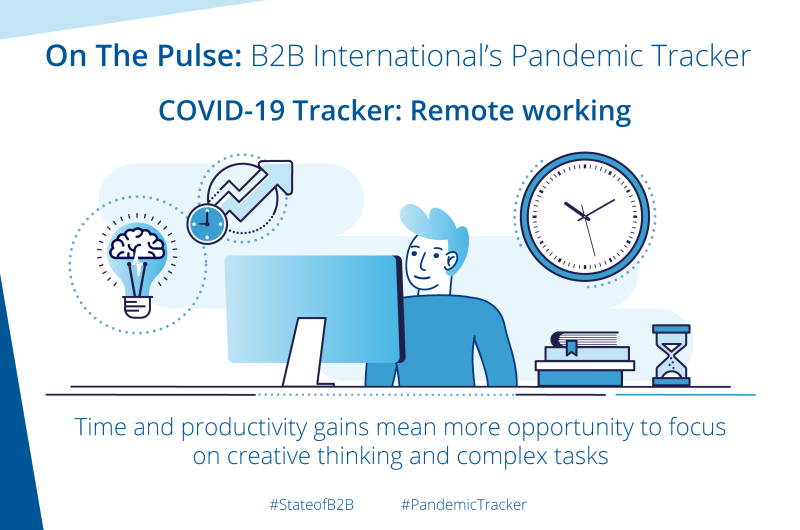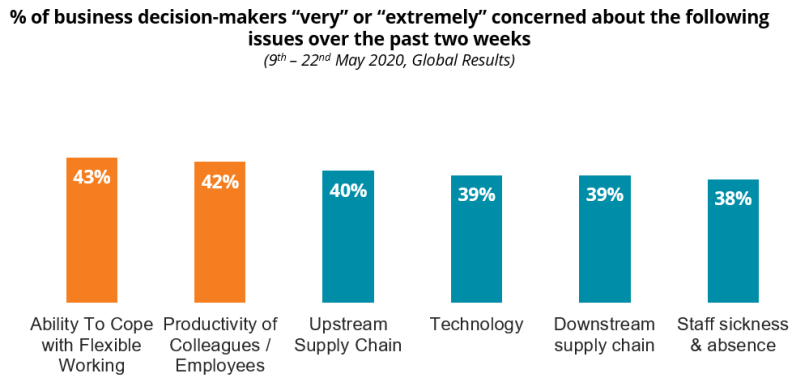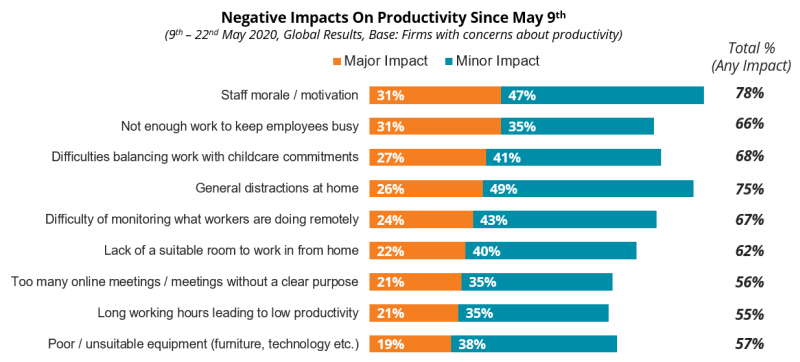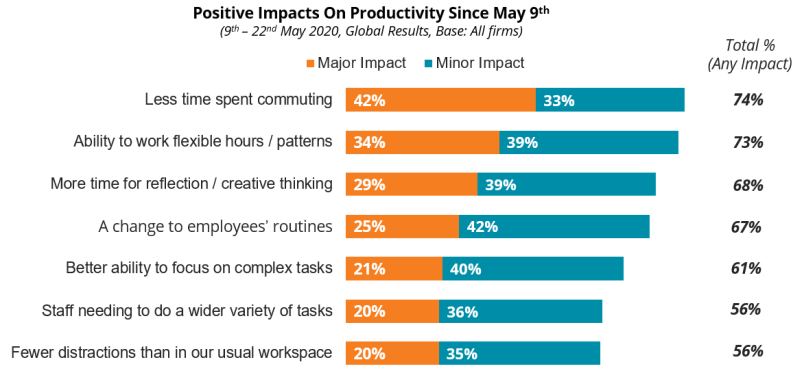As businesses begin formulating return to office strategies, how concerned are they about current productivity levels? And what downsides and potential upsides have they seen since making the shift to remote working? In this latest article we find that while there have been plenty of productivity challenges, many businesses are seeing some interesting opportunities arising from remote working.

Productivity Currently a Top Concern for Businesses
Data from our latest wave of research shows worries over ability to cope with flexible working and with productivity of colleagues and employees topping the list of concerns for businesses around the globe. More than four in 10 business decision-makers are very or extremely concerned about these issues, placing them at first and second, respectively, among all operational concerns we’ve asked about since the second week of May:

While productivity is a pressing concern for all businesses right now, the burden of ensuring that workers remain active and industrious are not shared equally across different regions: Concern over productivity of colleagues and employees seems especially high among organizations based in the Asia-Pacific region, where 53% are “very” or “extremely” worried about the issue. By contrast, organizations in the Americas seem significantly less troubled, as only one-third (33%) rated it very or extremely concerning.
This reflects the different stages of the pandemic that these regions are at right now – with Asia-Pacific significantly further through its initial phase of the crisis. What this suggests is that productivity may remain a persistent issue as we move toward recovery.
Reasons to Worry: Negative Impacts on Productivity
To understand the reasons behind these significant concerns over productivity, we asked businesses about a range of negative impacts they have seen to their business since early May, as well as how significant or extreme each of these impacts has been over this timeframe:

The results above indicate that productivity concerns are driven by a range of perceived problems. Altogether, 95% of concerned decision-makers indicated that at least one of the productivity problems listed above has impacted their business to some extent. Enterprises (those with 250 or more employees) generally register significantly higher proportions that have seen any impact from these challenges on their business, versus SMEs (<250 employees).
So what have the main issues been?
Top Challenges to Productivity
-
Motivation – Problems with staff morale and motivation top the list in terms of prevalence and impact, with nearly 8 in 10 (78%) citing this problem. Given the duress many have endured in balancing professional responsibilities with striving to protect themselves and loved ones from health impacts of COVID-19, it would be a surprise not to see morale as an issue. Job security created by economic uncertainty is also likely to be part of these worries.
The fact that this issue tops the list of productivity challenges should serve as a stark reminder to organizations that they are only as strong as their people: Making employees’ mental wellbeing a top priority is likely to become an even bigger focus in future in the context of productivity.
This need to focus and support employee mental health may, in part, be addressed by a growing array of mobile mental health and therapy apps that companies can encourage their employees to use. This includes apps such as Kite and Talkspace, as well as other mental health tools and resources. A further example of this is the free “Innen Leben” downloadable flashcard set recently developed and made available for free by a psychologist and psychiatrist in Germany.
-
Utilization – Simply having enough work to keep all employees occupied throughout the workday is problem for around two-thirds (66%) of businesses with concerns about productivity. And 3 in 10 see this as exerting a major negative impact.
Initiatives based around shortened working hours have started to be considered by some companies and governments. New Zealand’s prime minister, Jacinda Ardern, recently floated the idea of a national 4-day workweek aimed at both helping to bolster domestic tourism and also helping employees strike better, healthier work/life balance as the global crisis continues.
-
Distraction – “Difficulties balancing work and childcare commitments” and “general distractions at home” are significant, and linked, issues. The melding of work and home lives brings with it everyday distractions that impinge on working time. Whether it’s deliveryman ringing doorbells, construction workers jackhammering nearby or furry familiars leaping across keyboards, virtually everyone has a harder time staying focused and engaged when removed from their regular business environment. Given the diversity of home settings of employees, it has been challenging for many firms to devise an overarching strategy to mitigate this problem.
-
Supervision – The inability to monitor and manage employees represents the fourth and final major drawback for productivity that the working world has had to grapple with. This obstacle can make it difficult for managers to effectively delegate to and checking on their direct reports. It also directly exacerbates the two previously discussed issues of distraction and (lack of) utilization, since managers can no longer “catch” and refocus distracted employees, nor optimally allocate workloads across their various reports. Now more than ever, managers must be able to trust the initiative of employees.
-
Sub-optimal Setups – One less severe, but common issue with productivity is the issue of sub-optimal working environments – i.e. a lack of suitable workspaces and/or equipment. This issue has had a major impact on only around one-fifth of firms with productivity problems, although around 6 in 10 have seen it have some negative impact. While firms can do little to provide for a better room or space in which their employees can work remotely, they can certainly help in the form of better technology, tools and equipment. This is especially so if working from home is likely to continue for a significant while longer, as expected in many economies.
-
Time Management – The final challenge is individual and collective time management. Around 55% of firms to have seen their productivity negatively impacted report a surfeit of meetings that take up too much time and/or long working hours impinging on individual productivity. With so many organizations operating with reduced staff or reduced hours, being careful not to overload those employees becomes a priority. However, this is a difficult balance to strike given the pressures many firms face.
Other Struggles with Productivity
Looking on the Bright Side: Positive Impacts on Productivity
As ominous as the commercial horizon has become, business decision-makers still recognized a range of positive impacts on productivity across their organizations in recent weeks.

-
Extra Time Means More Time for Reflection and Creativity: First, workers have had the benefit of extra time to get their jobs done, not least in terms of time saved on business travel and commuting to work. Less time spent commuting has had a major positive impact on more than 4 in 10 organizations (42%), and some positive impact on around three-quarters (74%).
Having this extra time and space to themselves has allowed workers to put more thought and creativity into their outputs and deliverables. Around 3 in 10 (29%) reported major positive benefits here, with around two-thirds (68%) of companies surveyed saying this has had at least some impact. More time doesn’t always lead to more productivity, of course – However, gaining a significant chunk of extra time at the start and end of the working day, in particular, has likely helped in this regard.
-
Extra Flexibility: Many workers have recently gained additional flexibility to work preferred hours and patterns. Around a third (34%) of our sample cited this as a major positive impact, and even more (39%), cited it as having a minor positive impact on their business over the past few weeks. The closely related issue of changing routines was also cited as a major benefit by 25%.
-
Extra Responsibilities: A third and distinct benefit that more than half (56%) cited as exerting some positive impact on productivity is that of extra experience – i.e. employees being asked to do a wider variety of tasks than normal. Theoretically, if a given organization can accomplish a wider variety of things with the same or fewer resources, productivity will increase. One caveat here is that asking individuals to learn new processes or take on additional responsibilities may still have a time and productivity cost: They’ll need additional time to learn these new skills and even then may not be as efficient as those that previously specialized in these tasks.
-
Extra Intensity & Room to Focus on Complexity: The fourth and final productivity benefit since the advent of COVID-19 has been that of extra intensity or focus. For many roles, having solitary workspace away from the distractions of the usual, bustling workplace appears to have improved focus for some. While this benefit was only seen as having a major positive impact by around one-fifth of organizations, this was significantly higher in technology firms – here, 33% stated there had been major positive impacts. This aligns closely with software development or coding tasks.
Taken together, these results portray a complex and double-edged array of impacts to organizational productivity during COVID-19 so far. The ability of organizations to get work done has been hampered by issues of motivation, occupation, distraction, and supervision. At the same time, companies have seen many gains in productivity due to their workforces utilizing the benefits of extra time, flexibility, experience, and intensity.
These enforced changes to working patterns are, however, likely to provide strong pointers for businesses and policy-makers in helping to crack the “productivity puzzle” that many firms in mature economies had encountered even prior to the pandemic.
These findings are from the B2B International COVID-19 Tracker. They are derived from n=2,030 interviews with business professionals in SME and Enterprise firms in the UK, France, Germany, USA, Canada, China, Singapore, Australia and Japan. Fieldwork was conducted from 13th April – 22nd May 2020.



